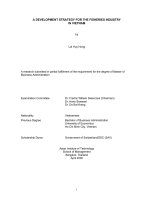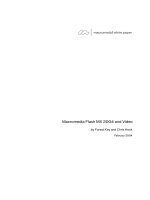JONES audio and video synchronization status
Bạn đang xem bản rút gọn của tài liệu. Xem và tải ngay bản đầy đủ của tài liệu tại đây (1.31 MB, 38 trang )
Audio/Video Synchronization
Standards and Solutions
A Status Report
Patrick Waddell/Graham Jones/Adam Goldberg
ITU-R BT.1359-1 (1998)
Only International Standard on A/V Sync
Subjective study with EXPERT viewers
– SDTV not HDTV images
– CRT displays, of course
At first glance it seems loose: +90 ms to -185 ms as a “Window of
Acceptability”
– In their terms, positive values are audio advanced relative to video, negative is
delayed relative to video
– We will examine these results more closely…
– The numbers were statistically significant for each point
Remember, the measurements were very carefully made
– Expert viewers
– 20” CRT monitors
– fixed viewing distances
2
ITU-R BT.1359 Figure 2
C
Undetectablity plateau
0
Subjective evaluation results (Diffgrade)
C'
B'
B
Detectability threshold
-0.5
-1.0
A
A'
Acceptability threshold
-1.5
Sound advanced wrt
vision
Sound delayed wrt vision
-200 ms
-150 ms
-100 ms
-50 ms
ITU-R BT.1359 Figure 2
3
0 ms
+50 ms
+100 ms
ITU-R BT.1359 Figure 2
Let’s quickly look at Figure 2 versus Fixed Pixel Display rates
– 30/1.001 Hz (or 33.3 ms per image)
– 25 Hz (or 40 ms per image)
This may be informative…
Subjective evaluation re
esults (Diffgrade)
Figure 2 with Fixed Pixel Display Timings Shown
5
Figure 2 with Fixed Pixel Display Timings Shown
25 Hz Frame Times (40 ms) shown
C
C'
Undetectablity plateau
0
B'
B
Detectability threshold
-0.5
-1.0
A
A'
Acceptability threshold
-1.5
Sound advanced wrt
vision
Sound delayed wrt vision
-200 ms
-150 ms
-100 ms
-50 ms
ITU-R BT.1359 Figure 2
6
0 ms
+50 ms
+100 ms
Fixed Pixel Display Timings
Interesting results
Note that both charts assumed interlaced video
– So 1080P/60 or 1080P/50 display times are half that shown
The measured values with CRTs line up fairly well with FPM times for
detectability
– Most of the ITU study measurements were with 25 Hz video (except the
Japanese, who used 30 Hz)
Note that the Acceptance threshold is merely 2 frames advanced for either
frame rate!
– Our brains are used to sound being delayed in nature (by distance)
– Our brains are confused when sound precedes the vision!
7
Lip Sync is an End-to-End Issue
1
1'
1''
Simplified Reference Chain
for television sound/vision timing
from ITU-R BT.1359 1998
2
Outside
Broadcast
Codec
Contribution
1
1'
1''
2
2'
3
3'
Compilation
Studio
Codec
Station
Local
(1)
Codec
Contribution
Undetectable from
-100 ms to5' +25 ms 6
Detectable at -125 ms & +45 ms
Becomes unacceptable at
-185 ms & +90 ms
(1)
8
4
Distribution
6'
Station
(1)
4'
Emission
Codec
STL
5
Local
transmitter
– Sound delayed
+ Sound advanced
Subjective Tests
• Subjective tests for the ITU-R BT.1359
standard were carried out in Australia, Japan
and Switzerland in 1995 and 1996
– Used PAL and NTSC video
– Tube cameras, 22” CRT displays
– 6x picture height
• New tests carried out this year by JEITA in
Japan
– HD, CCD cameras, large flat panel displays, 3x
picture height
– Results to be published later this year
– Will possibly show lower threshold levels
– ITU standard may need to be revised ??
9
ITU-R BT.1359 Thresholds
Undetectable from
-100 ms to +25 ms
Detectable at -125 ms at & +45 ms
Becomes unacceptable at
-185 ms & +90 ms
10
Recommended Tolerances
At the input to the transmitter/emission encoder
ITU BT.1359 1998
ATSC IS/191 2003
EBU R37
2007
-30 ms +22.5 ms
-45 ms +15 ms
-60 ms +40 ms
– Sound delayed + Sound advanced
Undetectable from
-100 ms to +25 ms
Detectable at -125 ms at & +45 ms
Becomes unacceptable at
timing
ATSC and EBU tolerances are for absolute
-185 ms A/V
& +90
ms errors
ITU tolerance is for the A/V timing difference in the path from the
output of the final program source selection element to the input
to the transmitter for emission
11
Link Budget
1
1'
1''
2
Outside
Broadcast
Codec
Contribution
-100 ms to +25 ms
1
1'
1''
2
2'
Codec
12
Station
4
Local
(1)
Codec
Contribution
Undetectable from
5'
6
-100 ms to +25 ms `
Detectable at -125 ms at & +45 ms
Becomes unacceptable at
-185 ms & +90 ms
(1)
3'
Compilation
Studio
Reference point
3
Station
(1)
4'
Emission
Codec
STL
Distribution
5
Local
transmitter
-30 ms +22.5 ms
6'
-100
-130 ms
+25
+47.5 ms
Broadcaster Tolerance
• Given the level of uncertainty of A/V sync
coming out of production and the:
– Variability of consumer devices
– Variability in viewing conditions
• In order to have reasonable expectation that
viewers will see acceptable lip sync:
– The broadcaster has no choice but to target a
very low or zero error through the chain from
reference point to emission encoder
– There is little or no spare budget to allocate!
13
Correct Sync Errors Where they Occur
• Good system design can correct for known and
predictable differential delays
–
–
–
–
Solid state cameras
Frame synchronizers
Vision switchers, format converters, etc.
Flat panel monitors with associated audio monitoring
• Fixed and variable delay compensation
– Available from various manufacturers
– Control signals from some video devices allow
automatic delay switching
– Care needed to avoid audio artifacts
• Some errors in the chain cannot be predicted or
corrected automatically where they occur
14
Out of Service Measurement
•
•
•
•
15
Clapper board
Electronic clapper boards
Beep-flash systems
Sarnoff Visualizer™
In Service Measurement
• Pixel Instruments LipTracker ™
• Asaca TuLips ™
– Both use sophisticated analysis of
lip movements and associated audio
sounds to establish an absolute
measurement of sync error at any point in
the chain
– Applicable when moving lips are clearly
visible
– May not be very practical for real world
broadcast systems
16
What Is Needed?
• A dynamic in-service method that can respond in
near real time
– Works while content is playing - not a calibration
method
• Not reliant on any specific signal format or
interface so it can be carried through all the
different parts of the entire signal chain
– Particularly needed for the professional parts of the
delivery chain
– Possible application for consumer devices
17
A/V Signature / Fingerprint / DNA
• Extract features from both audio and video and combine
together in an independent data stream
• Use fingerprinting methods that are resilient to
processing of the audio and video signals
– Designed to allow typical types of processing (data rate
compression, format changes, etc.)
• This data stream may be called an A/V Sync Signature,
Fingerprint, or “DNA”
– Relies on generating the signature at a point where A/V sync is
known to be correct
– From that point on the system is designed to measure and
maintain the relative audio/video timing that was present when
the signature was generated
18
A/V Synchronization Signature
Video Frames (e.g. 33.3 msec)
Video
Video
Video
Video
Video
Video
Video
Signature
Signature
Signature Signature
Signature
Signature
Signature
Audio
Audio
Audio
Audio
Audio
Audio
Audio
Signature Signature Signature Signature Signature Signature Signature
Audio
Signature
Audio
Signature
Audio
Signature
Audio
Signature
Audio
Signature
Audio
Signature
Audio
Signature
Audio
Signature
Audio
Signature
Audio
Signature
Audio
Signature
Audio
Signature
Audio Blocks (e.g. 10 msec)
19
Slide courtesy of Dolby
Audio
Signature
Audio
Signature
Audio
Signature
A/V Sync Signature Comparison
i
Sent in A/V Sync
Signature
Sig_Ra
Audio delay
Audio delay
i
Video delay
Extract Video
Signature
i
Av
Audio delay
i
Extract Audio
Signature
Aa
Compare
Signatures
Sig_Aa
Video delay
i
Compare
Delays
A/V Sync
Delay
Sig_Av
Compare
Signatures
Audio and Video Unknown Sync
Video delay
i
Sent in A/V Sync
Signature
Sig_Rv
• Difference between audio delay and video delay is the A/V
sync error
20
Slide courtesy of Dolby
A/V Sync Correction
Dolby A/V Signature Real-Time System
21
Slide courtesy of Dolby
A/V Sync Correction
Content Distribution
Network
File Server
File Server
A/V file
A/V file
A/V sync
signature
Extract
Audio & Video
Signatures
A/V sync
signature
Variable File Processing
Audio and
Video are
known to
be “in sync”
Unknown
A/V sync
Extract
Audio & Video
Signatures
Generate
A/V Sync
Signature
Signature
Comparisons
A/V Sync Signature
Generator Software
A/V Sync Detection/
Correction Software
Dolby A/V Signature File-based System
22
Adjust A/V
file sync as
necessary
Slide courtesy of Dolby
Meter
Display
Broadcast Chain
1
1'
1''
2
Outside
Broadcast
With a fingerprint system, all
errors occurring after the
reference point can be
measured and corrected prior
to encoding for emission
Codec
Contribution
1
1'
1''
2
2'
Station
Codec
5'
If adopted by consumer
devices, the same fingerprint
from the reference point could
possibly be used to correct
errors at the point of display
(1)
23
3'
Compilation
Studio
Reference point
3
Local
(1)
Codec
Contribution
6
4
Distribution
6'
Station
(1)
4'
Emission
Codec
STL
5
Local
transmitter
Products/ Technologies
•
•
•
•
•
Evertz IntelliTrak™
Miranda Densite HLP-1801
Sigma Electronics Arbalest™
K-Will QuMax 2000™
Dolby A-V Signature
– All use A-V signature / DNA / fingerprint metadata
– All assume correct sync at the input reference point
– All measure errors at downstream point, enabling
errors to be corrected automatically
24
A Standardized Fingerprint?
• Entire program chain usually not under
control of broadcaster
• From user’s perspective, it is highly desirable
for equipment from different manufacturers in
different parts of the chain to interoperate
• Is standardized fingerprint metadata for A-V
sync the solution ?
• Standardized transport methods ?
• Seeking input from broadcasters and users
on what they want from manufacturers
25









